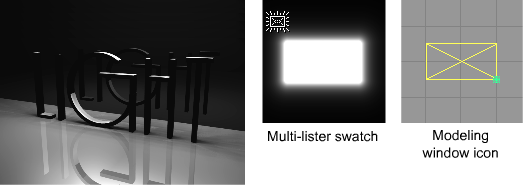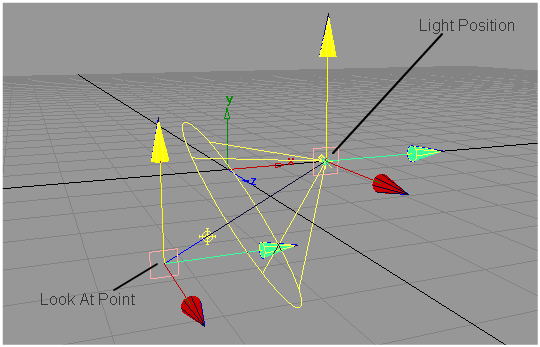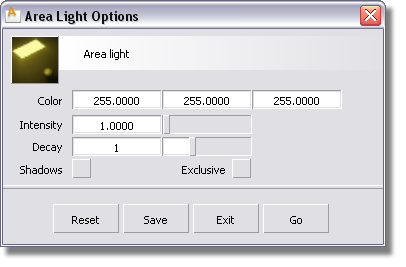Creates a rectangular light source useful for simulating lightbox reflections.
Area lights are two-dimensional
rectangular light sources. They are useful for simulating the rectangular
reflections of windows on surfaces. An area light is initially two
units long and one unit wide. Use Transform > Scale  and Transform > Non-p Scale
and Transform > Non-p Scale  to re-size an area light.
to re-size an area light.

The diffuse component of area lights is very small. To increase diffusion, move the light further away and increase its Intensity value. Area light shadows are much more costly than point light shadows. The increase in processing cost is proportional to the complexity of the scene and the size of the area light.
You can create a light using the Create light tools or using the Multi-lister. You can use the light options to set properties for any new light you create.
By default, lights are named sequentially as you create them: Light, Light#2, and so on. To avoid confusion, however, you should name all lights as you create them. If you let the system assign default names and later combine two or more files, all lights are renumbered to avoid duplicate names. It may then become difficult to distinguish lights by name.
To create a light using the Light tools

A new light swatch appears in the Multi-lister, and a new light icon appears in the modeling window. Each type of light has a unique modeling window icon and Multi-lister swatch.
In addition, light manipulators are displayed in the modeling window.
(To display the manipulators
for an existing light, select the Pick > Object  tool, select the light,
and select a Light tool.)
tool, select the light,
and select a Light tool.)

Most lights have one manipulator that controls the light’s position. Spot lights have two manipulators: one manipulator controls the light’s position, the other manipulator controls its direction (look-at point). Each manipulator consists of a square icon at its center, and three colored arrow icons radiating from the center in the X, Y, and Z directions.
By dragging a square
icon you can move the light or the light’s look-at point across
the view plane (in orthographic windows) or parallel to the ground
plane (in perspective windows). By holding the  (Windows) or
(Windows) or  (Mac) key while you drag
a square icon you can snap the light to grid points.
(Mac) key while you drag
a square icon you can snap the light to grid points.
By dragging an arrow icon you can move the light or the light’s look-at point in the X, Y, or Z direction.
To create a light using the Multi-lister
The Area Light Options can be opened using the Area light tool.

The brightness of the light. If the light exerts a force, this value sets its strength. A light with an Intensity value of 0 produces no light. A light with negative Intensity value removes light from a scene in the area of the light’s influence. The slider range is 0 to 100. The default value is 1.

Controls how quickly light intensity decreases with distance. The Decay setting has no effect at distances less than 1 unit. If Force is set (that is, not OFF) under Active Effects, the Decay value controls how quickly the force intensity decreases with distance.
The Decay parameter works differently for volume lights (see Decay). Valid settings are 0, 1, 2 or 3. The default setting is 1.
| 0 | no decay; light reaches everything |
| 1 | light intensity decreases directly (linearly) with distance (slower than real world light) |
| 2 | light intensity decreases proportionally with the square of distance (the same as real world light) |
| 3 | light intensity decreases proportionally with the cube of distance (faster than real world light) |

Makes the light only illuminate objects that are linked to that light. A light with Exclusive Link OFF illuminates objects that have no light links. The default setting is OFF.
Determines whether the light casts shadows or not. The default setting is OFF. Please note that only spotlights can cast shadows in a raycast image.